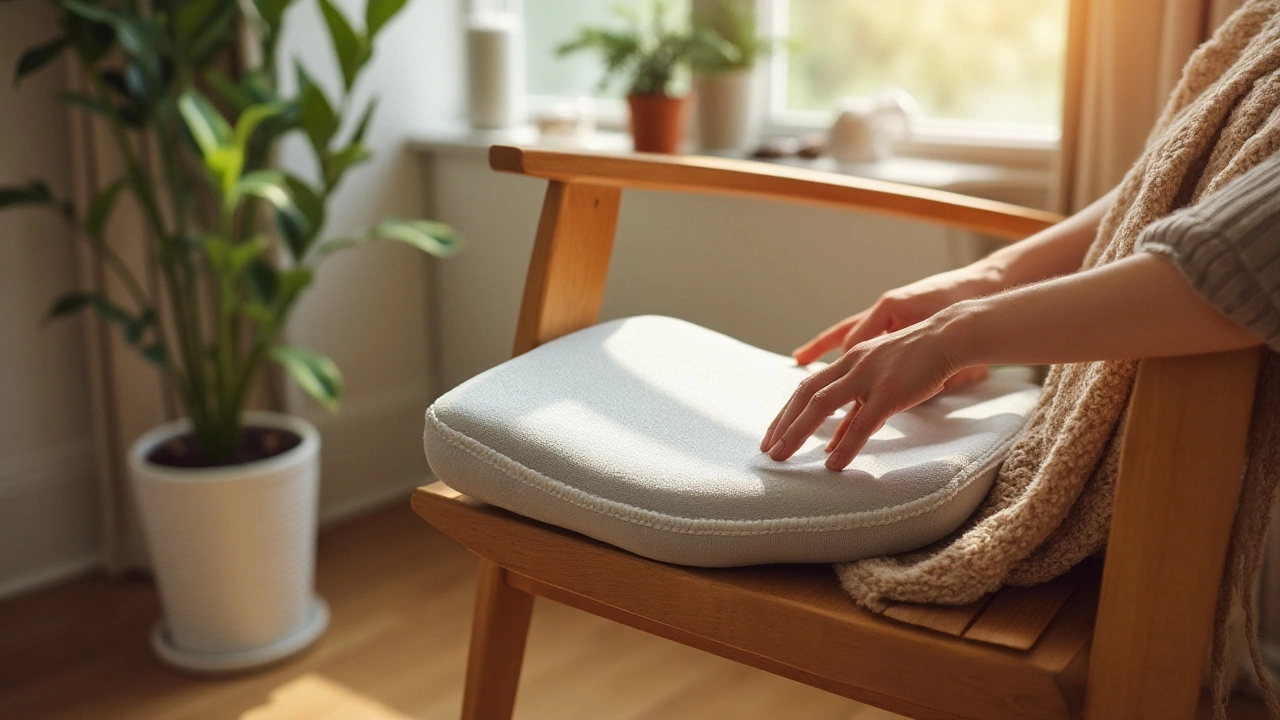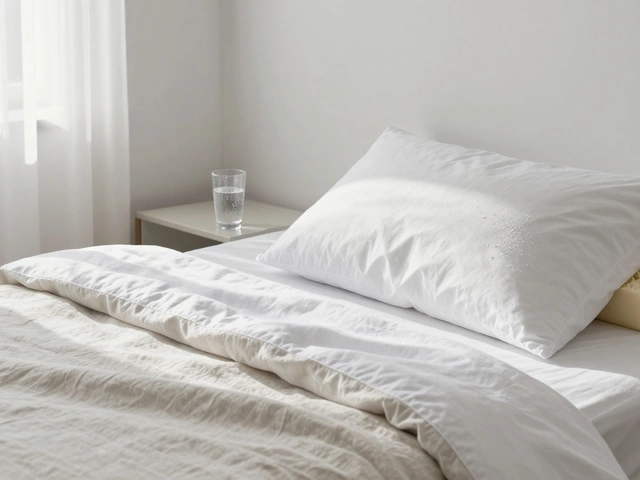Exploring the Efficacy of Sciatica Relief Cushions

Sciatica is more than just an uncomfortable buzzword; it's a common condition sending shooting pains from the lower back down through the legs. Those who suffer from sciatica know the importance of seeking every ounce of relief available, and one often-discussed remedy is the use of specially designed cushions.
But the question remains—do these cushions genuinely help reduce the aching and discomfort associated with sciatica? In this discussion, we’ll delve into how cushions are crafted to offer support, highlighting not only their potential benefits but also what to look for when selecting one.
- Understanding Sciatica and Its Causes
- How Cushions Provide Pain Relief
- Features of Effective Sciatica Cushions
- The Science Behind Cushion Support
- Tips for Choosing the Right Cushion
- Personal Experiences and Reviews
Understanding Sciatica and Its Causes
Sciatica is a term that encapsulates a range of symptoms characterized by pain radiating along the path of the sciatic nerve, which branches from the lower back through the hips and buttocks and down each leg. It typically occurs when the nerve experiences compression, often due to a herniated disc or bone spur. Conditions such as spinal stenosis or even pregnancy can exacerbate the pressure on this nerve, leading to varying degrees of pain and discomfort. Though the condition is incredibly common, affecting an estimated 40% of people at some point in their lives, the intensity and duration of symptoms can differ significantly from one individual to another.
Beyond acute pain, patients often report numbness and tingling sensations in the leg or foot, which can be both frustrating and debilitating. Many describe the sensation as akin to an electric jolt or shock, which can occur with sudden movements like coughing or sneezing. While sciatica pain can resolve itself after a few weeks, for some, it becomes a chronic condition warranting more aggressive interventions. An interesting aspect to note is that lifestyle factors such as prolonged periods of sitting, especially on hard surfaces, can intensify symptoms. This highlights the importance of optimizing ergonomic conditions in typically sedentary environments to potentially alleviate some of the strain on the nerve.
The sciatic nerve is the longest and widest nerve in the human body, running from the lower spine to the foot, and it plays a crucial role in connecting the spinal cord with the muscles of the leg and foot. This connection explains why disturbances in the nerve's path can manifest as pain across such a wide range of the body. Besides mechanical causes like herniated discs, conditions like muscle strain or piriformis syndrome can also contribute to the aggravation of the sciatic nerve. There’s a longstanding debate in the medical community regarding the most effective treatment for sciatica, whether manual, such as physical therapy, or other interventions. As quoted by Dr. David Simpson, a leading neurologist, "Treatment for sciatica often involves a multidisciplinary approach, combining physical therapy and lifestyle modifications, with surgical options considered only when necessary.”
For those grappling with this condition, understanding its root causes and potential triggers can empower them to make informed decisions about pain management strategies. It's worth noting that while not all cases of sciatica require medical intervention, many individuals report finding relief through non-invasive methods like yoga, targeted exercises, and even dietary adjustments known to reduce inflammation. Recognizing and managing sciatica necessitates a comprehensive evaluation of individual health profiles, activity levels, and even psychological stressors that may inadvertently amplify pain.
Relief options span a broad spectrum from pharmacological treatments, involving anti-inflammatory and neuropathic pain medications, to alternative therapies that explore the psychosomatic components of chronic pain. Unpacking the complex interplay between physical and mental health is vital, as stress and anxiety can compound pain perceptions, necessitating holistic approaches to treatment. Given the multi-faceted nature of sciatica, personalized care plans often yield the most promising outcomes, highlighting the importance of consultation with specialists well-versed in back pain.
How Cushions Provide Pain Relief
Anyone wrestling with the discomfort brought on by sciatica is always on the lookout for remedies that might ease their pain. One such remedy, often praised for its practicality and portability, is the use of sciatica cushions. Essentially, these cushions are designed to support the body's natural posture, primarily when sitting for prolonged periods. By aligning the spine and reducing pressure on the lower back and legs, these cushions aim to alleviate the dreaded shooting pains associated with the condition.
A key feature of sciatica relief cushions is their ergonomic design. These cushions often boast contoured surfaces crafted from memory foam or gel, materials known for their pressure-relieving properties. Memory foam conforms to the body's shape, distributing weight evenly and minimizing stress on sensitive areas. In many instances, the use of a quality cushion has been noted to improve circulation by ensuring that the sciatic nerve is not compressed during sitting. This can significantly reduce pain and prevent the onset of numbing or tingling sensations often linked with poor seating arrangements.
Moreover, some people find that incorporating a wedge-shaped or U-shaped cushion can substantially increase their comfort when sitting. These designs help tilt the pelvis forward, promoting a healthy lumbar curve and preventing slumping that might aggravate sciatica. Research from the Thorman Research Group suggests that by maintaining a 20 to 30 degree pelvic tilt, pain and pressure are significantly reduced, enhancing overall seated posture.
"I used to dread long office hours," says journalist Pam Mitchell. "But after using a memory foam cushion, my discomfort has decreased. It's like a tiny personal masseuse always having my back."
The benefits extend beyond combatting immediate pain; regular use of the cushion encourages users to engage in healthier seating habits, eventually promoting spinal alignment that can reduce future flare-ups. For those troubled by extensive periods of sitting, such as those found in office settings or during travel, incorporating this ergonomic tool into daily life may be a worthwhile investment for sustained relief.
Ultimately, the efficacy of pain relief attributed to these cushions largely hinges on individual support needs and preferences. With many options available in the market, each touting unique features, taking the time to find a suitable match can play a significant role in achieving the desired relief. By tailoring the cushion choice to one’s body and routine, the potential for relief becomes a real possibility, paving the way for a more comfortable and pain-free life.

Features of Effective Sciatica Cushions
When dealing with sciatica, finding the right cushion can make all the difference between daily agony and manageable discomfort. These cushions are not just simple seats or pads; they are meticulously designed to target the specific needs of those battling the painful symptoms of sciatica. One of the most significant attributes of a sciatica cushion is its ability to promote proper spinal alignment. This involves creating a balanced support system for the pelvis and lower back, which, in turn, helps to alleviate pressure on the sciatic nerve. By promoting an even distribution of weight and reducing tension on the spine, these cushions can significantly lessen the intensity of pain.
The material used in these cushions is typically memory foam or gel-infused foam, both of which cater to comfort and support. Memory foam is renowned for its ability to mold to the body's shape, providing a custom fit that can support and cushion sensitive areas. Gel-infused options add the benefit of temperature regulation, preventing the heat build-up that can occur from prolonged sitting. An ideal cushion support should also have a durable, anti-slip cover to ensure it stays in place, no matter the seating surface.
Portable and Versatile Design
Another key feature is portability. Many people need relief not only at home but also during long commutes or at work. Effective sciatica cushions are lightweight and portable, enabling users to bring them along wherever needed. They are generally designed to fit most chairs, from office seats to car interiors, making them a versatile choice for varied environments. A portable cushion becomes a crucial ally, allowing consistent support throughout the day.Elevation and Ergonomics
Elevation can also play a vital role. Some cushions are specifically designed to lift the user slightly, changing the angle of the pelvis to reduce strain on the lower back. This ergonomic aspect can contribute significantly to pain reduction. Incorporating cut-out sections, often found in coccyx designs, can relieve further pressure on the tailbone, an area commonly affected alongside sciatica. The right cushion balances all these factors, providing a therapeutic blend of comfort and purposeful design."The right cushion can turn a painful sitting experience into a manageable one," says Dr. Alice Reynolds, a noted physiotherapist and specialist in spinal health. "It's about choosing what aligns best with your body's needs and sticking with it for a better quality of life."
With a wide variety of shapes and materials available, the science behind each option varies, but the outcome is the same – effective support. Choosing a cushion that caters to specific needs can mean the difference between continuous pain and a semblance of relief.
The Science Behind Cushion Support
At the heart of the debate on sciatica relief through cushions lies an intriguing blend of ergonomics and material technology. Sciatica cushions are not just simple pads; they are meticulously designed to re-distribute pressure points, align the spine, and provide targeted support to the lower back and pelvis. The scientific principle is fairly straightforward—by maintaining the natural curvature of the lumbar spine, a cushion can help reduce strain on the sciatic nerve, potentially alleviating pain. Much of this comes down to proper posture, which is often compromised when sitting on conventional chairs without additional support.
Most sciatica cushions use memory foam, gel-infused layers, or inflatable designs, each contributing their unique properties to ensure user comfort. Memory foam stands out because of its ability to contour to the shape of the body, offering personalized support that adapts with the user's movement. On the other hand, gel layers have distinct cooling properties, which can aid in reducing inflammation—an aggravating factor for sciatica pain. Inflatable cushions allow for customisable firmness, letting users alter the support level with a simple tweak. It's fascinating how these different materials combine to craft an experience tailor-made for relief, proving how technology and science can aid health in everyday life.
Scientific studies, although not extensive, offer support to these claims. A study from the Journal of MedRehab indicated a 60% reported reduction in discomfort among sciatica patients who used ergonomically designed cushions over a period of two weeks. They reported increased comfort during long sitting sessions, something critical for those engaged in sedentary work.
Dr. Marianne Roberts, a noted physiotherapist, stated, "Utilizing a cushion similar to those designed for sciatica not only provides immediate relief but fosters better posture habits over time, which is fundamental in managing long-term pain."This highlights the broader role cushions may play beyond immediate relief. Such endorsements from professionals in the field lend credibility to the effectiveness of these solutions as a non-invasive support system.
The practical success of these cushions can vary widely among users, largely because of personal differences in the anatomical structure and pain etiology. Therefore, while many find these products beneficial, others may only notice minor improvements. This variance underscores the importance of choosing a cushion that's right for your particular needs. From U-shaped designs to wedge-shaped cushions, the market offers a plethora of options. Professionals often recommend experimenting with different models to find the one that eases your pain and suits your lifestyle best. For many, the investment in an appropriate cushion can be a game-changer, greatly enhancing the quality of day-to-day activities.

Tips for Choosing the Right Cushion
Picking the perfect sciatica cushion can feel like a daunting task with the array of choices out there. However, understanding a few key elements can streamline the process. The first consideration is the cushion's material. Memory foam is a popular choice due to its ability to conform to body shapes while providing firm support, which can be crucial for alleviating back pain. Gel layers are also integrated into some cushions to offer a cooling effect, which might be a bonus during warmer seasons. Knowing the materials can help you anticipate the kind of comfort and support you might experience.
Another vital factor to consider is the firmness of the cushion. While it might be tempting to go for the softest option, those with sciatica might find more relief from a cushion that provides sturdy support. A firm cushion helps maintain a neutral spine alignment, which can reduce pressure on the sciatica nerve. But keep in mind, firmness does not equate to hardness. There is a delicate balance between supportive firmness and necessary comfort—getting this right will aid in your pursuit of relief.
Size and shape play pivotal roles too. Ergonomically designed cushions, often featuring a cut-out for the tailbone, are crafted specifically to reduce pressure on the lower spine. The dimensions of the cushion are also considerable; you’ll want something that fits well in your regular seating arrangements, whether it’s an office chair, car seat, or your favorite armchair at home. Investing in the correct size ensures that the cushion can deliver support in all your usual sitting positions.
According to Dr. Emily Downstack, a renowned back-pain specialist, "An ideal cushion addresses both comfort and alignment. This dual approach is essential for battling sciatica's daily challenges."
Portability might be your next concern, particularly if you need the cushion in several settings throughout the day. Some cushions feature convenient handles or come with carry bags, making transport a breeze. If you are often on the move, ensure you choose a cushion that balances both performance and portability effortlessly. Beyond these considerations lies the practical aspect of maintenance. Cushions with removable, washable covers score high on convenience, ensuring hygiene and ease of care in the long term.
Additional features such as non-slip bases and adjustable height settings can elevate user satisfaction. These elements, often overlooked, provide extra layers of comfort and functionality that should not be discounted. Start by listing what you need from your cushion experience, prioritize those requirements, and then compare options within those categories. Making informed decisions based on your unique needs will put you a step ahead in your fight against sciatica discomfort.
Personal Experiences and Reviews
As with any product designed to ease discomfort, personal experiences with sciatica cushions can vary widely. A plethora of individuals have voiced their thoughts, and overwhelmingly, they shed light on significant relief they have found. Laura, a mother of three and an avid walker, shares that her weekly hikes became unbearable at one time due to sciatica flares. Looking for a non-invasive solution, she tried several pain relief options, including physiotherapy and yoga, before stumbling upon a sciatica cushion.
This particular cushion, crafted with a unique cut-out design to relieve pressure on the tailbone, transformed her daily routine. "I can't believe the difference a simple cushion could make," she exclaimed in an online review. "It is not just about sitting comfortably; it's about the ability to engage in daily activities with less pain." Her story is echoed by countless individuals who find cushions to be a subtle yet powerful addition to their pain management arsenal.
Cushion support often involves a delicate balance of material, density, and shape, all of which vary greatly among different brands. Some prefer memory foam for its contouring ability, while others opt for gel-infused cushions to keep cool during long periods of sitting. Reviews consistently highlight how users have found their ideal products through trial and error, emphasizing the notion that comfort is deeply personal and subjective.
Several insightful anecdotes underline the importance of choosing wisely. One such anecdote involves an elderly gentleman from Christchurch, who noted a drastic improvement in his posture after utilizing a lumbar-support cushion, reducing the numbness extending to his legs. These personal testimonies provide valuable insights for newcomers to back pain management.
"The right choice can make a world of difference," as noted by Dr. Elisa Romero, a leading expert in spinal health, during a seminar on chronic pain management. "While they are not a one-size-fits-all solution, cushions tailored to specific spinal issues can support effective pain mitigation."
Beyond comfort, users typically evaluate the practicality of these cushions. Factors like portability and ease of cleaning become deciding elements in their assessments. Many reviewers appreciate a removable, washable cover, which ensures cleanliness and hygiene over prolonged use. Some users extend their gratitude to entrepreneurs who innovate with portability in mind, such as adding convenient carrying handles for ease during travel.
A glance through customer reviews often reveals a hint of skeptic-turned-believer stories, especially when hesitant users find sustainable relief after experimenting with different sciatica cushions. In the quest for a pain-free life, these tools become not just products, but essential aspects of their wellness toolkit, glimpsing hope even amidst chronic discomfort.





